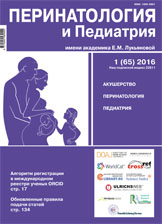Спинальный дизрафизм. Клинико-неврологические и диагностические особенности. Случаи из практики
DOI:
https://doi.org/10.15574/PP.2016.65.125Аннотация
В статье приведены основные сведения об актуальной проблеме современной медицины - спинальном дизрафизме, в частности, Spina bifida. Несмотря на определенные достижения методов пренатальной диагностики и профилактических мероприятий, указанная аномалия является одной из распространенных врожденных аномалий и значительным инвалидизирующим фактором, обуславливающим оптимизацию пренатальной и постнатальной диагностики, предупреждения и лечения указанного порока. Приведены клинические случаи из практики.
Библиографические ссылки
Bitsadze VO, Makatsariya AD. 2007. Printsipyi profilaktiki razvitiya defektov nervnoy trubki ploda. Farmateka. 1: 26—28.
Vrozhdennyie poroki razvitiya: prenatalnaya diagnostika i taktika. Pod red BM Petrikovskogo, MV Medvedeva, EV Yudinoy. 1-e izd. Moskva, RAVUZDPG, Realnoe vremya, 1999: 256.
Elikbaev GM, Hachatryan VA, Karabekov AK. 2008. Vrozhdennyie spinalnyie patologii u detey. Shyimkent: 80.
Adzick NS, Thom EA, Spong CY, Brock JW. 2011. A Randomized Trial of Prenatal versus Postnatal Repair of Myelomeningocele. N Engl J Med. 364: 993—1004.
Adzick NS. 2010. Fetal myelomeningocele: natural history, pathophysiology, and in(utero intervention. Semin Fetal Neonatal Med. 15(1): 9—14. http://dx.doi.org/10.1016/j.siny.2009.05.002; PMid:19540177 PMCid:PMC3248827
Appasamy M, Roberts D, Pilling D, Buxton N. 2006. Antenatal ultrasound and magnetic resonance imaging in localizing the level of lesion in Spina bifida and correlation with postnatal outcome. Ultrasound Obstet Gynecol. 27(5): 530—536. http://dx.doi.org/10.1002/uog.2755; PMid:16619377
Burmeister R, Hannay HJ, Copeland К et al. 2005. Attention problems and executive functions in children with Spina bifida and hydrocephalus. Child Neuropsychology. 11(3): 265—283. http://dx.doi.org/10.1080/092970490911324; PMid:16036451
Banich MA, Brown W. 2000. A lifespan perspective on interaction between the cerebral hemispheres. Developmental Neuropsychology. 18(1): 1—10. http://dx.doi.org/10.1207/S15326942DN1801_1; PMid:11143800
Barnes M. 2004. Reading and writing skills in young adults with Spina bifida and hydrocephalus. Journal of the International Neuropsychological Society. 10(5): 655—663. http://dx.doi.org/10.1017/S1355617704105055; PMid:15327713
Botto LD, Moore CA, Khoury MJ. 1999. Neural tube defects. N Engl J Med. 341: 1509—1519.
Canfield MA, Marengo L, Ramadhani TA. 2009. The prevalence and predictors of anencephaly and Spina bifida in Texas. Paediatr Perinat Epidemiol. 23(1): 41—50. http://dx.doi.org/10.1111/j.1365-3016.2008.00975.x; PMid:19228313
Chen CP. 2008. Prenatal diagnosis, fetal surgery, recurrence risk and differential diagnosis of neural tube defects. Taiwan J Obstet Gynecol. 47: 283—290.
Lindquist B, Uvebrant Р, Rehn Е, Carlsson G. 2009. Cognitive functions in children with myelomeningocele without hydrocephalus. Childs Nerv Syst. 25(8): 969—975. http://dx.doi.org/10.1007/s00381-009-0843-5; PMid:19263057
Vannemreddy P, Nourbakhsh А, Willis В, Guthikonda B. 2010. Congenital Chiari malformation. Neurology India. 58(1): 6—14. http://dx.doi.org/10.4103/0028-3886.60387; PMid:20228456
Dias MS. 2005. Neurosurgical management of myelomeningocele (Spina bifida). Pediatr Rev. 26: 50—60.
Moldenhauer JS, Soni S, Rintoul NE, Adzick NS. 2014, Aug. 15. Fetal Myelomeningocele Repair: The Post-MOMS Experience at The Children's Hospital of Philadelphia Fetal Diagnosis and Therapy.Published online.
Mizuno J, Nakagawa H, Yamada T, Watabe T. 2002. Intrathoracic giant meningocele developing hydrothorax: a case report. J Spinal Disord Tech. 15: 529—532.
Juranek J, Salman MS. 2010. Anomalous development of brain structure and function in Spina bifida myelomeningocele. Developmental Disabilities. 1: 23—30.
Mitchell LE. 2005. Epidemiology of neural tube defects. Am J Med Genet C Semin Med Genet. 135: 88—94.
Mitchell LE. 2004. Spina bifida. Lancet. 364(9448): 1885—1895.
Kibar Z, Torban Е, McDearmid JR, Reynolds А. 2007. Mutations in VANGL1 Associated with Neural—Tube Defects. N Engl J Med. 356: 1432—1437.
Nikkila А, Rydhstrom H, Kallen B. 2006. The incidence of Spina bifida in Sweden 1973—2003: the effect of prenatal diagnosis. European Journal of Public health. 16(6): 660—662. http://dx.doi.org/10.1093/eurpub/ckl053; PMid:16672253
Gutierrez FR, Woodard PK, Fleishman MJ et al. 1994. Normal anatomy and congenital anomalies of the spine and spinal cord. In: Osborn A.G., Maack H. (eds.). Diagnostic neuroradiology. 1st ed. St. Louis: Mosby: 785—819.
Paladini D. 2007. Sonographic examination of the fetal central nervous system: guidelines for performing the «basic examination» and the «fetal neurosonogram». Ultrasound Obstet. Gynecol. 29: 109—116.
Rose BM. 2007. Attention and executive functions in adolescents with Spina bifida. Journal of Pediatric Psychology. 32(8): 983—994. http://dx.doi.org/10.1093/jpepsy/jsm042; PMid:17556398
Sebold CD, Melvin EC, Siegel D. 2005. Recurrence risks for neural tube defects in siblings of patients with lipomyelomeningocele. Genet Med. 7: 64—67.
Fletcher JM, Copeland К, Frederick JA. 2005. Spinal lesion level in Spina bifida: a source of neural and cognitive heterogeneity. J Neurosurg. 102; 3 Suppl: 268—279.
Griffiths PD, Porteous M, Mason G, Russel S. 2012. The use of in utero MRI to supplement ultrasound in the foetus at high risk of developmental brain or spine abnormality. The British Journal of Radiology. 85: e1038—e1045.
Thompson DNP. 2010. Spinal dysraphic anomalies; classification, presentation and management. Paediatrics and Child Health. 20(9): 397—403. http://dx.doi.org/10.1016/j.paed.2010.03.011
Pilu G, Ghi T, Carletti A et al. 2007. Three-dimensional ultrasound examination of the fetal central nervous system. Ultrasound Obstet Gynecol. 30: 233—245.
Tortori-Donati Р, Rossi А, Cama А. 2000. Spinal dysraphism: a review of neuroradiological features with embryological correlations and proposal for a new classification. Neuroradiology. 42(7): 471—491. http://dx.doi.org/10.1007/s002340000325
Vinck A, Nijhuis-van der Sanden MW, Roeleveld NJ. 2010. Motor profile and cognitive functioning in children with Spina bifida. Eur J Paediatr Neurol. 14(1): 86—92. http://dx.doi.org/10.1016/j.ejpn.2009.01.003; PMid:19237302
Williams LJ, Rasmussen SA, Flores A. 2005. Decline in the prevalence of Spina bifida and anencephaly by race/ethnicity: 1995—2002. Pediatrics. 116(3): 580—586. http://dx.doi.org/10.1542/peds.2005-0592

